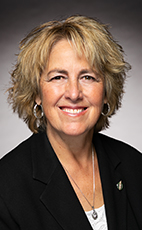44th Parl. 1st Sess.
May 18, 2023 10:00AM
- May/18/23 3:59:29 p.m.
- Watch
Madam Speaker, I rise in this chamber today to speak on this motion.
In my riding, the community of Richmond Centre, I have heard of many heartbreaking incidents. Michael, an artist, an empath and a gentle, compassionate young individual passed away at age 26 from a tainted supply of drugs. Curtis was an intelligent, caring and adventurous person. He was 36 when he passed away from drug overdoses and poisonings. Countless incidents like these happen in British Columbia and across Canada. It breaks my heart to see mothers, fathers, friends and families lose their dearly loved ones.
Last year, in Richmond, 29 people died of drug poisoning, and 2,314 died in British Columbia. On CBC news today, it said that in British Columbia 206 people were suspected to have died of toxic drugs in April alone this year.
Let us talk about the link between mental health and substance use. We know that mental health and substance use is affecting more and more Canadians and requires collaboration across all levels of government as well as with other partners in our community. It is for that reason that, in 2021, Canada’s first-ever ministry of mental health and addictions was created, and showed the interconnected nature of mental health with substance use.
It has also highlighted our government’s commitment to take action through an integrated approach on these issues that have significantly impacted individuals, their families and communities. It is important to stress that mental illness and substance use often go hand in hand. People with mental illnesses are twice as likely to have a substance use disorder compared to the general population.
Substance use can also increase the underlying risk of mental health issues and can exacerbate the symptoms of existing mental health issues. In fact, 50% of people in treatment for substance use also live with mental illness. We know that childhood trauma, low income, lack of access to stable housing, discrimination, racism, and the historical and ongoing effects of colonization and the residential school system on indigenous communities all play a major factor.
There are many challenges faced by Canadians experiencing mental illness and harms from substance use. These include a lack of available services and supports close to home, care that is not comprehensive or responsive to an individual’s needs, and the experience of stigma and discrimination, both in seeking care and in society.
Youth and young adults, indigenous peoples, Black Canadians and those identifying as LGBTQ2S+ are among those Canadians impacted the most. As a result of unmet or under-addressed mental health and substance use needs, individuals and communities face significant health, social and economic burdens. This includes paying out of pocket for services, increased emergency department visits and public safety concerns.
Our government has long recognized that Canadians with mental health and substance use needs require ongoing supports to meet a complexity of needs. We have seen the record of the Conservatives on this issue. They stand up in the chamber and use stigmatizing language to try and play politics with this issue, and act like they are not misleading Canadians with a bias or one-sided perspective on this crisis.
Canadians have spoken of the complexity of these mental health and substance use issues, and how often they are interconnected with other social issues, such as homelessness.
For example, we know that up to 75% of women experiencing homelessness also experience mental illness. In British Columbia, 67% of people experiencing homelessness or housing instability identified substance use issues, and 51% identified mental health as a concern.
Accessing appropriate housing options that provide ready access to needed wraparound supports can be a significant challenge, due to housing shortages and maintenance issues with existing housing; insufficient community-based, trained provider capacity; and silos between health, housing and social sectors.
This is why our government is investing in affordable housing for Canadians, including $4 billion through the rapid housing initiative, aimed at quickly creating new affordable housing for individuals who have severe housing needs and are at risk of being homeless.
Ensuring Canadians have access to housing, social supports and the health services they need is a major preoccupation of municipal and community leaders. Our government is working with them, and with the provinces and territories, to break down silos, so Canadians can have access to the integrated supports they need.
We are also committed to working with indigenous governments and communities to support access to a comprehensive range of evidence-based, culturally appropriate and trauma-informed services and supports needed to support mental health and substance use issues that individuals are facing, including the opioid overdose crisis, and to advance whole-of-society approaches to these issues.
Through the mental wellness program, Indigenous Services Canada is providing supports for substance use prevention, harm reduction, treatment and aftercare, psychosocial wraparound services and trauma-informed health supports to indigenous communities. In addition, our government has provided targeted supports for innovative community-based projects that address mental health and substance use issues.
The opposition members will stand up and say that the government is not putting resources into treatment, but since 2017, we have invested more than $400 million in over 380 projects through the substance use and addictions program to support community-based organizations.
In 2018, our government committed $150 million over five years to address the opioid crisis through the emergency treatment fund, which also had funds cost-matched by provinces and territories: over $300 million in funding for substance use treatment across Canada.
This shows how much we are putting into treatments and how we should not be taking lessons from a party that wants to revert to Harper-era policies. Tackling the opioid overdose crisis requires a holistic and integrated approach that focuses on mental health and well-being. That is what this government has been doing, so that Canadians can be resilient and healthy now and into the future.
Enough is enough.
We will not be able to bring loved ones home if they are dead from toxic supplies. This is a fight that we must triumph. This is a non-partisan issue, and we will prevail with collaboration with provinces, territories, municipalities and local community organizations, such as, in my riding, the Richmond Addiction Services Society, Turning Point Recovery Society and Pathways Clubhouse.
I want to thank the Minister of Mental Health and Addictions for her continuous championship on this matter, and all the first responders, frontline workers and health care workers for all they do.
1091 words
- Hear!
- Rabble!
- add
- star_border
- share
- May/18/23 4:08:54 p.m.
- Watch
Madam Speaker, it is interesting. Earlier in the House we heard about vaping numbers going up. What we know in this opioid crisis is that the Liberal government is installing vending machines for high-potency drugs in Vancouver and Victoria. I wonder if the member opposite might think that it would be appropriate to give free vaping products in high school vending machines.
63 words
- Hear!
- Rabble!
- add
- star_border
- share
- May/18/23 4:09:21 p.m.
- Watch
Madam Speaker, I would like to take a common-sense approach. Would anyone want their kids to access toxic drugs through a vending machine or want drugs to be accessible in the community, so that children have easy access to substances that are harmful to their health? I think our government is working very hard to create more programs to support the people in need in this overdose crisis.
69 words
- Hear!
- Rabble!
- add
- star_border
- share
- May/18/23 4:10:00 p.m.
- Watch
Madam Speaker, I thank my colleague for his speech. I read the Conservative motion and I noticed that it uses a rather harsh word. It refers to deadly programs.
Personally, I do not get the impression that the government is trying to kill people. I would like my colleague to comment on that. What is the actual purpose of these programs? I doubt it is to kill people.
68 words
- Hear!
- Rabble!
- add
- star_border
- share
- May/18/23 4:10:33 p.m.
- Watch
Madam Speaker, I thank the hon. member her question. I hope she will excuse me for responding in English.
Our government is invested heavily in harm reduction with the four pillars recognized internationally as the necessary, successful substance use strategy, which is based on prevention, enforcement, treatment and harm reduction. However, if people die, there is no way for us to help them or offer them any treatments we provide. Therefore, it is important for us to understand what is needed in our communities to address this opioid crisis.
89 words
- Hear!
- Rabble!
- add
- star_border
- share
- May/18/23 4:11:28 p.m.
- Watch
Madam Speaker, we know Conservatives are trying to mischaracterize the entire situation. One of the effects of the harm reduction approach that is being proposed is that it helps connect people to other health services, including the possibility of treatment and rehab. However, if they do not make that connection, that is never going to happen.
My question for the member is this. When Conservatives say we should eliminate harm reduction initiatives, such as safer supply, how on earth would we be able to successfully connect people to other services when we cannot even reach them?
96 words
- Hear!
- Rabble!
- add
- star_border
- share
- May/18/23 4:12:17 p.m.
- Watch
Madam Speaker, I absolutely agree. To parse that, as a government, we need to look after Canadians, and it is important for us to really bridge the connection between mental wellness and substance use. It is important that we do not stigmatize this topic, because that would create fear in the community and we would be misleading Canadians. That will not help this opioid crisis. It is important for us to address the fact that we are here to prevent deaths in our communities because of the opioid crisis.
89 words
- Hear!
- Rabble!
- add
- star_border
- share
- May/18/23 4:13:05 p.m.
- Watch
Madam Speaker, it is important to note that the Leader of the Opposition was part of a government that tried to muzzle scientists with respect to climate change. He was also part of a Conservative team that undermined public health officials with respect to the pandemic and all things related to the vaccine.
Now the Leader of the Opposition pretends to know more than trained professionals and doctors with respect to the opioid crisis we are dealing with.
My question for my friend and colleague is this. Can he reiterate why it is so important to rely on doctors and the medical profession as it relates to the response to this crisis?
112 words
- Hear!
- Rabble!
- add
- star_border
- share
- May/18/23 4:13:39 p.m.
- Watch
Madam Speaker, I would say it is important for us to base our response on science and facts, not on quotes from media sources that offer no evidence behind them. It is important for us to understand what helps to minimize deaths in the community.
45 words
- Hear!
- Rabble!
- add
- star_border
- share
- May/18/23 4:14:13 p.m.
- Watch
Madam Speaker, I will be splitting my time with the hon. member for Sherwood Park—Fort Saskatchewan.
Today, we are addressing the health of our nation. After eight years of the Prime Minister, everything feels broken, especially in my home province of British Columbia. Drugs, disorder and violent crime are all on the rise in our neighbourhoods. People are lining up at food banks in record numbers because they cannot afford groceries. Many cannot afford a home, and, worst of all, the opioid crisis is claiming the lives of our sons and daughters. Under the watch of the Prime Minister, there have been 34,000 opioid deaths, and that number is growing by the day. In B.C. alone, overdose deaths are up 330%, by far the worst rate of all the provinces.
The B.C. coroner released a report today, saying that 206 people died of overdose in April. That is 206 people, including one at a safe injection site, who died in one month. The report said that 70% of victims were between the ages of 30 and 59. People in that age bracket should be buying a home, having children and enjoying a successful career. Instead, in the Prime Minister's Canada, they are chasing their next hit. Why is that? It is because all three levels of government, including the federal Liberals, the provincial NDP, this NDP caucus and left-wing mayors and councils, have decriminalized illicit drugs, flooded the streets with so-called safe supply and failed to create the treatment and connection needed for people suffering with addictions to build a drug-free life.
Over 800 people have died in the first four months of this year. If overdose deaths continue at this pace, we could lose up to 2,400 British Columbians this year. Death by overdose cannot be normalized. Instead, we need treatment and recovery. These programs will help those struggling with addictions and we need them now.
The Liberal-NDP coalition is flooding our streets with drugs and supercharging this opioid crisis. One Global News reporter took to the streets of Vancouver to find out where all these safe supply drugs are going. The reporter was able to buy 26 hits of safe supply drugs for only $30, in just 30 minutes, in Vancouver's Downtown Eastside. Outreach workers in Vancouver's Downtown Eastside claim that the safe supply hydromorphone tablets can be bought for as little as 25¢ per pill on the streets. It is no wonder that the B.C. coroner reports that seven people per day are dying from drug overdoses in my province.
This heavy amount of free drugs on our streets perpetuates the addiction cycle, prolongs suffering and prevents recovery. It is leading to more deaths, not fewer. How many more Canadians must die before the Prime Minister learns that treatment, not free drugs, saves lives? We need to help get people off drugs so that they can effectively address their addiction issues, enjoy improved health, reconnect with family, get jobs and become contributing members of society.
Let us be clear. The government's radical agenda is fuelling the opioid crisis. It uses the term “safe supply” as though it were a medical term, but, in truth, that phrase is nothing more than marketing jargon used by big pharma. Let us speak the truth. There is nothing safe about safe supply.
The Liberal and NDP drug pushers point to other jurisdictions that have decriminalized hard drugs to justify their radical agenda. For example, they say that Portugal set the gold standard for decriminalization of illicit drugs, but they forgot to mention that Portugal ensured that treatment and recovery services were expanded before they changed the laws. They also omit that health outcomes in Portugal have worsened since that country decreased treatment services.
What is worse is that they are ignoring a made-in-Canada model that is saving lives in Alberta. That province has become a beacon of hope for how lives can be turned around, with professional, caring drug treatment services. I hear members clapping; it is worth clapping for. Overdose deaths are down in that jurisdiction by 30%, while B.C. overdose deaths continue to climb.
We know that merely providing safe supply drugs will never get people out of an addiction cycle. When Conservatives form government, we will follow Alberta's example by building world-class recovery communities and implementing similar services around the country to save lives.
We also need to consider the impact that the so-called safe supply program is having on our youth. On the streets of Vancouver, people living with addictions are selling these cheap drugs to kids. They then use the money to buy stronger, deadlier fentanyl. Impressionable youth are accessing this cheap, plentiful supply of highly addictive drugs as a gateway to harder, more dangerous substances. In plain terms, the safe supply program is a direct threat to the lives of our youth.
A report from the B.C. coroner confirmed that overdose victims are trending younger and that opioid addiction among B.C.'s youth is increasing. Speaking as a mother, I say that we cannot allow the government to ignore the evidence when our teenaged sons and daughters are lying face down on a sidewalk in a zombie-like state. Safe supply drugs are putting youth on the path to hard-core addictions, and this needs to stop. Too many parents have lost children to drug overdoses in this country.
The story of Jack Bodie, from Burnaby, is far too common. Jack was a productive and active 17-year-old boy who was deeply loved by his family. Tragically, Jack snorted half a pill laced with fentanyl. Inhaling the drug slowed down Jack's breathing and heartbeat, and within minutes, his entire system shut down and he passed away. Jack's death sent his family into deep and profound grief. His dad, now a treatment and recovery advocate, maintains that the real tragedy is that there are thousands of families across Canada dealing with the same grief that he faced over the death of a child due to a drug overdose.
Police constable David Steverding works in Vancouver's Downtown Eastside, and he is a member of the Odd Squad, a group of dedicated police officers who provide drug use prevention education to youth throughout Canada. The constable has worked with hundreds of people living with addiction, and with their families. He said that people often say using drugs is a personal choice and a victimless crime, but that these comments overlook the friends and family members, who, he notes, are often completely helpless, standing by and watching while the drug user spirals downhill.
To the families that have tragically lost sons and daughters to a drug overdose, my message is this: We will make sure their child did not die in vain. We will scrap the dangerous social experiment of safe supply and ensure other kids who struggle with addictions get the treatment they need so they can come home to their families drug-free. The consultants and big pharma that turbocharge opioid marketing will pay for it. We will hold them to account as government policy.
Recovery, treatment and rehabilitation are how we are going to bring home our loved ones. It is how we will turn hurt into hope. It is the common sense of the common people. Hope is possible, and hope is on the way.
1250 words
- Hear!
- Rabble!
- add
- star_border
- share
- May/18/23 4:23:02 p.m.
- Watch
Madam Speaker, the Conservative Party sometimes insinuates that the Liberal government wanted to legalize all drugs.
British Columbia, for example, decriminalized some substances so that people with addictions could be connected to the right resources and get the right care.
Would the Conservative solution not end up packing prisons with people who have a serious health problem, thereby reinforcing the social stigmas against these people who need help and who want to quit using?
74 words
- Hear!
- Rabble!
- add
- star_border
- share
- May/18/23 4:23:39 p.m.
- Watch
Madam Speaker, shame on that member for what he just stated. There was nothing in what I said that said anything about prisons. That is ridiculous. We are talking about treatment, recovery and support for those who are suffering from addictions. Shame on him.
44 words
- Hear!
- Rabble!
- add
- star_border
- share
- May/18/23 4:24:04 p.m.
- Watch
Madam Speaker, I thank the great member for South Surrey—White Rock for such an interesting speech, and for taking a very complex subject and making it understandable for all Canadians.
Can the member comment briefly on the wisdom of spending $3.5 million in taxpayer money on these vending machines, three of which are in Vancouver and one in Victoria, her home province, and increasing access to powerful opioid-type medications?
73 words
- Hear!
- Rabble!
- add
- star_border
- share
- May/18/23 4:24:34 p.m.
- Watch
Madam Speaker, the member is a medical doctor, so he is always very knowledgeable on these subjects.
Of course I do not agree with this. The easier the access, the harder it is to deal with the problems that come from that easy access. These are young people whose brains are still developing. A brain is not fully developed until one is in their mid-20s. We know that, and we know the effects of drugs. Even so-called softer drugs, like marijuana, can lead to psychosis and paranoia and can unmask schizophrenia. Now, we are talking about drugs where a 17-year-old can snort half a pill and die. It is irresponsible and unreasonable to spend taxpayers' dollars to give young people access, such as at a vending machine, to hard drugs. It is unforgivable, actually.
138 words
- Hear!
- Rabble!
- add
- star_border
- share
- May/18/23 4:25:46 p.m.
- Watch
Uqaqtittiji, there has been information collected that shows that, because of safe supply programs, there has been a significant decrease in hospitalizations for infectious complications among safe supply clients. Hospitalizations dropped from 26 in the year before the program to 13 in that year. I wonder how the member interprets such helpful data, which shows that these safe supply programs do work.
62 words
- Hear!
- Rabble!
- add
- star_border
- share
- May/18/23 4:26:30 p.m.
- Watch
Madam Speaker, I have spent a fair amount of time in this space. I was the president of Little House, which is a recovery house in British Columbia, so I have some knowledge on the issue. A continuum of care, of course, has to be part of recovery, support and treatment. However, unlimited safe supply, where people receiving that safe supply are then selling it to kids cheaper and cheaper in order to then use that money for their own harder drugs, is a tragedy. People who run recovery houses like Last Door Recovery Society in New Westminster are on record saying that 100% of the people they deal with who have received safe supply drugs have never used all of the drugs they have received. They are selling them.
130 words
- Hear!
- Rabble!
- add
- star_border
- share
- May/18/23 4:27:32 p.m.
- Watch
Madam Speaker, after eight years of the Prime Minister, everything feels broken. Life costs more. Work does not pay, and housing costs have doubled. The Prime Minister divides to control the people. Worst of all, crime and chaos, drugs and disorder rage in our streets. Nowhere is this worse than the opioid crisis, and that has expanded so dramatically in the last several years.
Across the board, we see that the government is not working. That is why I am in full support of today's opposition motion, which proposes to reverse the damage being done by the Liberal government's drug policy and advances an authentically compassionate alternative approach to the opioid crisis.
Conservatives believe in universal and immutable human dignity. When it comes to those who are struggling with addiction, we believe in both meeting people where they are at, helping them pursue an ambition for recovery, and doing it successfully.
The approach of all of the other parties in this place reflects a basic pessimism about the potential of those struggling with addiction. They want to meet people where they are at, but leave them there, while we want to meet people where they are at and help them pursue recovery. Parents, brothers, sisters and friends do not just want to see those struggling receive a kind of palliative care. They want to see us take the steps that would allow those who are struggling to come home drug free.
This means that we need to make smart choices with scarce resources by investing those resources in treatment and recovery instead of spending those dollars to buy dangerous drugs and give them a away. The approach of every other party in the House is to dramatically increase the supply of dangerous hard drugs into our neighbourhoods. They argue that this is an appropriate response to the drug supply being poisoned, and because of a poisoned drug supply, they want to offer cleaner versions of these drugs.
Let us be clear, hard drugs are poison. Giving away taxpayer-funded poison is not a solution to people being poisoned. Giving away less potent versions of these drugs ignores the nature of opioids themselves. Opioids have a tolerance-inducing effect, which means that people generally need higher and higher doses to achieve the same impact. If a person is on a course of treatment and recovery, where they are offered targeted alternatives with unique properties, then they can go the other way. However, absent the intentionality, the reflexive course of opioid use is a dangerous upward escalator. Free, government-funded opioids today would still lead to the use of even more potent, unregulated opioids tomorrow.
As we are seeing now, this policy of supplying government-funded hard drugs into neighbourhoods and communities does not just hurt those who are already facing addictions. It also makes these hard drugs more plentiful, more available and easier for vulnerable kids to access for the first time. We know this because of what we are seeing in B.C., where these so-called safe supply policies have been tried. We also know this because of the particular history of the opioid crisis. This is where I want to focus my remarks today.
Where did the current opioid crisis come from? The evidence shows us that most people who struggle with opioid use disorders did not start down this road by experimenting with street drugs. They started down this road because a family-owned pharmaceutical company called, Purdue Pharma set out, starting in the 1990s, to revolutionize pain management through the aggressive marketing of OxyContin, and sought to make a lot of money in the process.
This history is well told in a number of books. I would recommend Empire of Pain by Patrick Radden Keefe, Dreamland by Sam Quinones and chapter seven of When McKinsey Comes to Town.
Here is the essential background: Opium is the original opioid, and there was a long-standing reluctance in the medical community to prescribe it, except in the most extreme cases. Purdue Pharma sought to create the impression that OxyContin, its new semi-synthetic opioid was less potent than opium. It was actually more potent. OxyContin also incorporated a controlled release technology. It was designed to facilitate a controlled release of opioid-related pain relief over a period of time. This also helped create an illusion of less risk.
However, OxyContin's controlled release mechanism was not tamper resistant. It could easily be modified to release all of the hit at once. It carried all of the same risks as, in fact greater risks than, opium. Purdue Pharma made unfounded claims minimizing the addiction risk associated with OxyContin and aggressively marketed it as the solution for all kinds of pain, not only acute pain following an extreme event but also ongoing chronic pain. It was marketed as a low-risk powerful pain relief option, and it was marketed very successfully.
As a result, many people with different levels of short-term and long-term pain had the opioid OxyContin prescribed to them. Then, because of the now well-known tolerance-inducing effect associated with opioids, people could not get the same level of pain relief at the same dose. They would seek higher and higher doses, and eventually transition away from just prescription drugs to street drugs as well.
For those here or elsewhere who have lost loved ones to opioid use disorders, many will recognize this story. There is pain, perhaps from a car accident or a long-running, unexplained, chronic pain, and then opioids are prescribed, followed by opioid addiction, and a subsequent spiral as higher and higher doses are sought to achieve the same effect. Perhaps, at some point, people seek treatment and recovery, but they find a complete lack of accessible services available.
Purdue Pharma's objective was to minimize any concern or stigma around its new product OxyContin. When it was released in 1996, OxyContin was a new drug, and indeed false claims were made to minimize its risk. It was also sold generally through regulated pharmacies.
This was not about stigma. It was not about unpredictability of supply or alteration of supply. This is actually a test case of what happens when drugs are easily available with little or no stigma. In effect, the overpromotion of opioids by Purdue and others with dangerous pharmaceutical-grade drugs made easily available was the original safe supply program, and that is what gave us the opioid crisis in the first place.
Needless to say, for pioneering this original safe supply program, Purdue is not getting any congratulations. It has become a global pariah and the name of the Sackler family, who owned Purdue, is being stripped off of the universities and art galleries they donated to. This original safe supply program is now seen for what it is. It was an elaborate scheme to market the problem of pain and then sell a solution that was far worse than the problem, undertaken contrary to the evidence and with the sole aim of making one family rich.
Conservatives have advanced a simple proposal in response to the wrongdoing associated with this first attempt at making big pharma rich through so-called safe supply. Our proposal is that Purdue Pharma, the Sackler family and all of the other bad actors involved, including McKinsey, pay compensation for the full cost associated with the opioid crisis and that the government spend 100% of the dollars collected through such litigation to fund treatment and recovery. The government needs to be ready to step up and help, yes, but let us make those responsible for this problem pay to fix it to fill the treatment and recovery gap.
I have not had time to review all of the history here, but there is one piece that I think is particularly noteworthy. The original formulation of OxyContin was said to go off patent in the United States in 2013. However, likely in an effort to extend patent exclusivity, Purdue Pharma released a new formulation of OxyContin with certain abuse-resistant features. It then filed papers with the FDA asking the agency to reject generic versions of the original pill on the grounds that the original version was unsafe. Purdue also pulled the original formulation from the U.S. market. The FDA concurred with the company and blocked generic re-formulations in the U.S. This led to the marketing of a new, somewhat safer, tamper-resistant product, but it also allowed Purdue Pharma to continue to have patent exclusivity in the United States and make even more money.
However, while both Purdue and the FDA said that the original formulation was unsafe, Purdue continued to sell the original, easier-to-abuse version here in Canada for a full year after the original OxyContin was off the shelves in the United States. In other words, Purdue was selling a drug in Canada which they had explicitly lobbied the FDA in the United States to be unsafe. Notably, sales rose dramatically in border areas, quadrupling in Windsor, suggesting that the company knew that the more dangerous versions of the drug were being sold in Canada and smuggled back into the United States. Purdue admitted that it was aware of the resulting spike in OxyContin sales in Canadian border towns. This is clear evidence of Purdue's extreme malice and of the particular impact that this has had for Canadians.
What can we learn from these events? First of all, we need to be constantly aware of the risk of large companies overmarketing potentially dangerous products. This is the cause of the opioid crisis, and we are seeing risks of this happening in other cases. We also must learn that so-called safe supply does not work. Trying to minimize the recognized risks associated with clearly dangerous products, making them widely available through pharmaceutical sales, clearly does not work. It did not work then, as it gave us the opioid crisis in the first place, and it is not working now.
To deter this kind of behaviour, we need to punish the perpetrators of this crime. The perpetrators are not those suffering from addiction, but the bad, elite actors who push these drugs onto people who are unaware of the risks, and who sought to minimize those risks. Therefore, I am pleased to support this motion and to move an amendment to it, which brings in this concept of holding bad actors responsible and of using the resources thus gathered to fund treatment and recovery.
I move, seconded by the member for—
1769 words
- Hear!
- Rabble!
- add
- star_border
- share
- May/18/23 4:37:37 p.m.
- Watch
The member's time is up. I did indicate to the member the one-minute mark. The time is at zero now.
Mr. Garnett Genuis: I started reading it.
The Assistant Deputy Speaker (Mrs. Carol Hughes): I have checked with the officers. There were just a few seconds in between, so I will allow the hon. member to move his motion.
61 words
- Hear!
- Rabble!
- add
- star_border
- share
- May/18/23 4:38:39 p.m.
- Watch
Madam Speaker, I move:
That the motion be amended by adding the following:
“and to directly sue the companies responsible for causing and fuelling the opioid crisis for all damages associated with the crisis and direct all funds recovered through such litigation to prevention, treatment, and recovery programs.”
50 words
- Hear!
- Rabble!
- add
- star_border
- share
- May/18/23 4:38:59 p.m.
- Watch
I would remind members to keep track of the time, and I did indicate that, because they can lose that opportunity.
It is my duty to inform hon. members that an amendment to an opposition motion may be moved only with the consent of the sponsor of the motion, or in the case that he or she is not present, consent may be given or denied by the House leader, the deputy House leader, the whip or the deputy whip of the sponsor's party.
Since the sponsor is not present in the chamber, I ask the acting deputy whip if he consents to this amendments' being moved.
108 words
- Hear!
- Rabble!
- add
- star_border
- share
- menumenu
- notificationsnotifications
- home
- mailmail
- searchsearch












